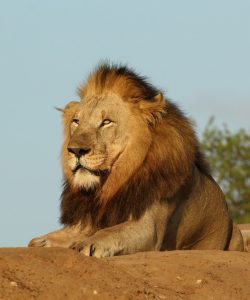Lion
- Scientific Name : Panthera leo
- IUCN Status : Vulnerable
- The lion is a large cat of the genus Panthera native to Africa and India.
 It has a muscular, broad-chested body, short, rounded head, round ears, and a hairy tuft at the end of its tail.
It has a muscular, broad-chested body, short, rounded head, round ears, and a hairy tuft at the end of its tail.- It is sexually dimorphic; adult male lions are larger than females and have a prominent mane.
- The lion is a muscular, broad-chested cat with a short, rounded head, a reduced neck and round ears.
- A new-born lion has dark spots, which fade as the cub reaches adulthood, although faint spots often may still be seen on the legs and underparts.
- African lions live in scattered populations across sub-Saharan Africa. The lion prefers grassy plains and savannahs, scrub bordering rivers and open woodlands with bushes.
- It rarely enters closed forests.
- Lions spend much of their time resting; they are inactive for about twenty hours per day.
- Although lions can be active at any time, their activity generally peaks after dusk with a period of socialising, grooming and defecating.
- Intermittent bursts of activity continue until dawn, when hunting most often takes place.
- They spend an average of two hours a day walking and fifty minutes eating.
- The lion is the most social of all wild felid species, living in groups of related individuals with their offspring.
- The lion is a generalist hyper carnivore and is considered to be both an apex and keystone predator due to its wide prey spectrum.
- Although adult lions have no natural predators, evidence suggests most die violently from attacks by humans or other lions.
